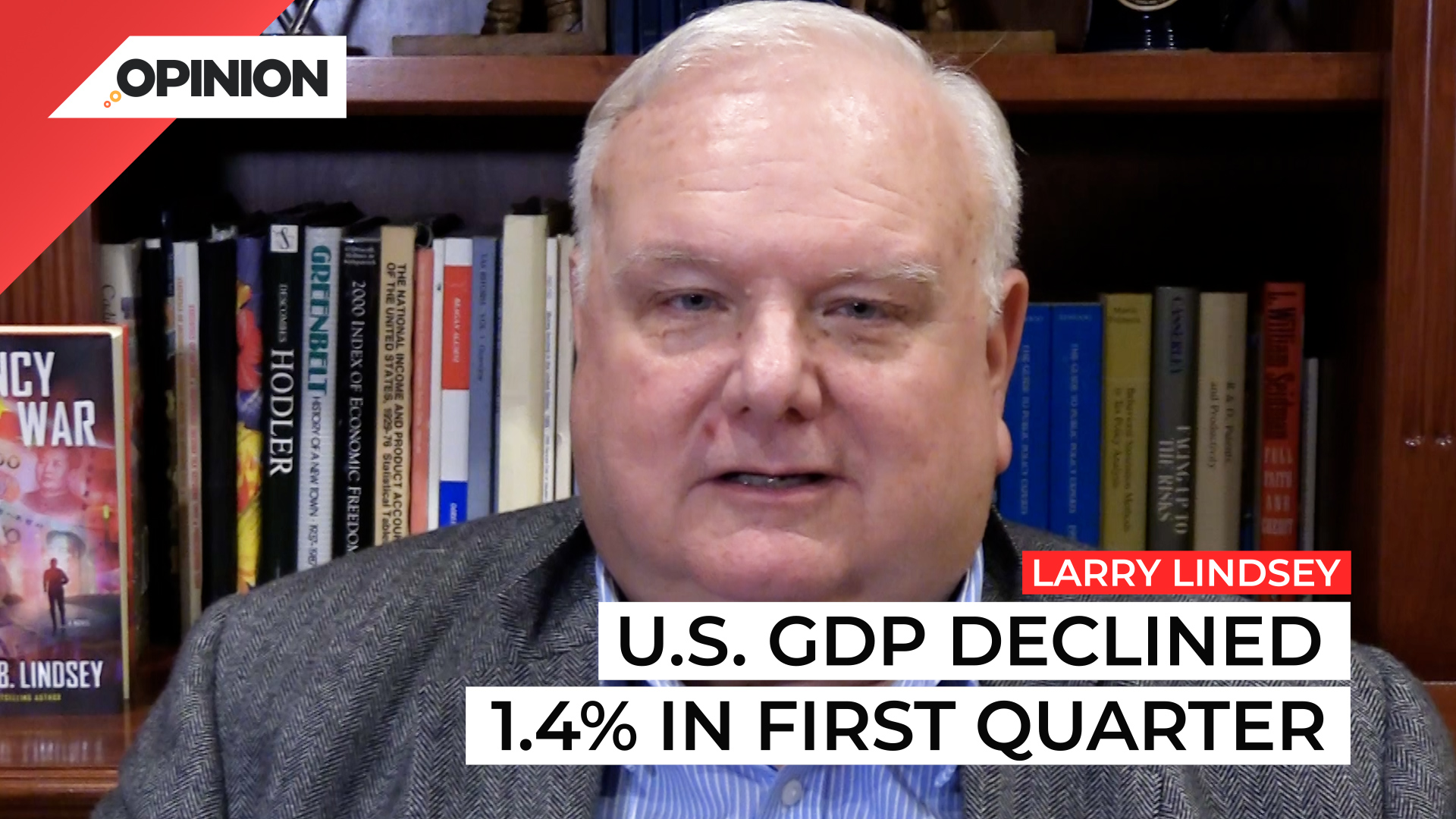
Commentary
-
Our commentary partners will help you reach your own conclusions on complex topics.
Recently, it was reported that real GDP in America declined 1.4% in the first quarter. Well, the natural question is what does that mean? It basically comes down to less goods and services, less economic activity happened in the first quarter of this year, compared to the fourth quarter of last year.
It’s not the end of the world. These sort of things happen. But when you look closely at the data, you begin to understand why it happened. And the main problem is inflation is running very, very hot. What they call the GDP deflator, which is the price of the entire market basket of everything that’s produced, rose 8% in the first quarter, compared to 7.1% in the fourth quarter of last year, and much, much lower rates around 2% as recently as 2020. Well, when the price of things goes up and there’s only so much ability for people to spend that need necessarily creates a problem for the amount of real goods and services that can be sold. Hence the problem.
This one is often described as having unusual factors being the cause. Well, yes and no. One of the quote, unusual factors really isn’t unusual at all at the time of inflation and that’s a very, very tight labor market. Well, when you have a tight labor market, it means you can’t produce things here. And if you can’t produce things here, you’ve gotta produce things abroad. And that means higher imports.
So, imports don’t help our GDP. They help the other country’s GDP. Import prices in the first quarter of this year, rose at an annual rate of 13.9%. 13.9% is enormous. And that meant that the volume of imports, actually declined by …excuse me, went up by 270 billion. We really needed the goods. We had to pay a lot more for them. And that 270 billion really was a subtraction from our GDP. There were other problems, again, all inflation related.
One was construction activity, both houses and offices and factories and cost of building went up at an annual rate of 17.7%. Unbelievable. So pressure on home prices is gonna continue to rise. Home, uh, prices are then going to be compounded by rising mortgage rates, which are now basically charging 5% or more, excuse me, compared to 3% very recently.
This is going to result in a plunge in housing affordability. And it’s going to mean again, another drag on the economy going forward. Will all this add up to a recession? We’ll have to see.
The national bureau of economic research has a committee that actually determines when something is a recession. It usually takes about six or eight months after the numbers come in for them to reach that decision. And there are four criteria that they use. One is the unemployment rate. Right now, that is 3.6%. It’s gonna be tough to get that much lower. It’s more likely to rise than to fall. And that’s a warning sign. Industrial production in the first quarter was up. That’s a positive for no recession. Real final business sales declined by six tenths of a percent. And the final indicator, real personal income, excluding transfers, also declined. So right now we are at two indicators of the four pointing to recession, one uncertaiN, and the other one good, but may not go any better. So watch out ahead.
The chances that the first quarter was a harbinger of the start of a slow period of growth is obvious. Whether it was the start of a recession remains to be seen. My bet is it probably will end up that way – mild, short, but a recession nonetheless.
-
Election 2024 will boil down to the Great Lakes states
Pollsters and pundits have been engaged in a long debate about how Biden or Trump might win the 2024 election, with much of their focus spent on the “swing state” electoral battlegrounds. While the winners of Alabama or California may be obvious, for instance, who wins Pennsylvania is a more difficult question. Watch the above…
-
Why the Fed should consider Theory of Reflexivity when fixing policy
The Theory of Reflexivity, often used in the context of economics and financial markets, implies that investors don’t base their decisions on reality but on their perceptions of reality. This creates a feedback loop where investors’ perceptions influence economic fundamentals, which in turn alter investor perceptions. Watch the above video as Straight Arrow News contributor…
-
Federal Reserve surpassed its own wildest expectations
On May 14, the U.S. Bureau of Labor Statistics released the most current producer price index (PPI) report, which showed an increase of 0.5% month-over-month in April. After the report’s release, U.S. Federal Reserve chairman Jerome “Jay” Powell said that while he believes the current policy rate is restrictive by many measures, the Fed needs…
-
Polls give slight advantage to Trump in Electoral College
With the U.S. general election only six months away, leading candidates President Joe Biden and former President Donald Trump appear to be engaged in a very close contest. In their 2020 race, the winner of the Electoral College was ultimately determined by a relative handful of voters in just a few swing states, even though…
-
College sports is big money but not everyone benefits
March Madness has wrapped up and Caitlin Clark has emerged as a household name as well as a wealthy student athlete. Earning over $3 million throughout her college career, her success stands in stark contrast to the previous notion that collegiate athletes shouldn’t earn anything beyond their scholarship. Straight Arrow News contributor Larry Lindsey examines…
Latest Opinions
-
 U.S. Department of Defense
U.S. Department of Defense
Congress still trying to figure out how to reduce wasteful military spending
-
 DVIDS
DVIDS
US Navy, Air Force making waves with new weapons at RIMPAC
-
 Getty Images
Getty Images
Israeli PM Netanyahu meets with Trump at Mar-a-Lago
-
 Getty Images
Getty Images
Growing US nuclear power resurgence reaches the nation’s heartland
-
 Getty Images
Getty Images
Beer from the sun, other solar thermal projects get government funding
Popular Opinions
-
In addition to the facts, we believe it’s vital to hear perspectives from all sides of the political spectrum.


